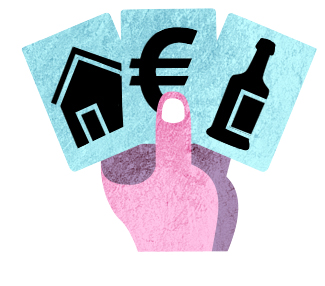What grade is your kid in?
29 October 2010 | Non-fiction, Tales of a journalist
Should a journalist show his hand? Columnist Jyrki Lehtola ponders the pros and cons of showing one’s true political colours
What’s the best way to present an initiative that would get the cynical, lazy news media to take an interest in the outside world?
The easiest way is to make a proposal in which the outside world is actually defined as the news media itself.
This is exactly what Matti Apunen did early this autumn: Apunen, a long-time journalist and the former editor-in-chief of the Aamulehti newspaper, had just left the paper to lobby for Finnish industry and trade interests as director of the Finnish Business and Policy Forum EVA.
He presented the Finnish media with a straw poll, following the Swedish model, in which reporters would anonymously answer questions about their political leanings.
The media immediately began grumbling, feeling that their illusory freedom was being threatened again in some vague way.
In the best traditions of Finnish discourse, they began with ad hominem attacks. Then they panned the idea by using themselves as counterexamples: I don’t know about everyone else, but I for one have voted for different parties in different elections.
Even though the discussion remained at that level, it continued for months in the Finnish media, because, according to journalistic logic, the public defense of a journalist’s integrity nicely underscores the presumed integrity of all.
Finland is the promised land not only for non-profit organisations but also for political parties. According to the most recent counts, we have around 1,480 parties, of which eight are represented in parliament.
Things are different in the civilised world. Out there, not every malady or personal problem requires the establishment of a political party; but rather, the established parties take up those problems and maladies in their own agendas. For example, in Great Britain, a land of two-and-a-half political parties, a study on the party leanings of reporters would be pointless: their political views are expressed clearly enough either by the articles they write, how those articles are headlined, or by where the reporter’s employer has situated itself on the media’s liberal/conservative axis.
And besides, more and more often a rough determination of political affinity can be made based on the reporter’s age instead of having to resort to a survey. People have a tendency to become more conservative with increases in age, income and indebtedness.
A reporter’s fumbling political leanings may not have much significance in his or her choice of perspective on a news story, but other criteria do. One still finds bias in reporters’ stories, but instead of party affiliation, it is determined by hundreds of contextual factors and dependencies from the reporter’s own personal life. It would be a good idea to highlight these contextual factors sometimes in a disclaimer at the end of the article, if it weren’t for the fact that they would take up just as much space as the article itself.
Relevant factors in addition to party affinity include sexual orientation, location of residence, size of mortgage, marital status, spouse’s profession, children’s ages and stages in schooling, degree of alcoholism, circle of friends, circle of enemies and those numerous youthful desires and dreams that went unfulfilled, somehow leaving a bitter taste in the mouth.
When the government is considering removing the mortgage interest tax deduction, the reporter’s attitude is not determined by party, but rather by the size of his or her mortgage and by how much this interest deduction means to the reporter.
Another significant influence on a paper’s relationship with the world is its editor-in-chief. It still isn’t a question of who the editor votes for in elections, but rather what his or her social and cultural networks look like.
Is the editor-in-chief an arts person or a sports person? What interest group bigwigs are represented at his dinner parties and with whom does he just have lunch? Who has been wining and dining the editor-in-chief in Lapland, and who is cross enough with him not to invite him to important networking events out of spite.
Over the past few decades, the media has changed, giving reporters more power over what attitudes news stories are coloured with. There are altogether too many regular columns and editorials in the papers, giving reporters the opportunity to tell us what we should think about each piece of news. In some situations it would be appropriate for the reporter to present the reasons related to his personal life why he thinks about a certain thing a certain way.
But more often than not this would be pointless: reporters aren’t so good at writing that the reader can’t tell from the sidebar that, ‘Aha, this writer has a mortgage, an alcohol problem, a marriage in crisis and two kids between the ages of nine and fourteen in comprehensive school’.
Translated by Owen Witesman
No comments for this entry yet

